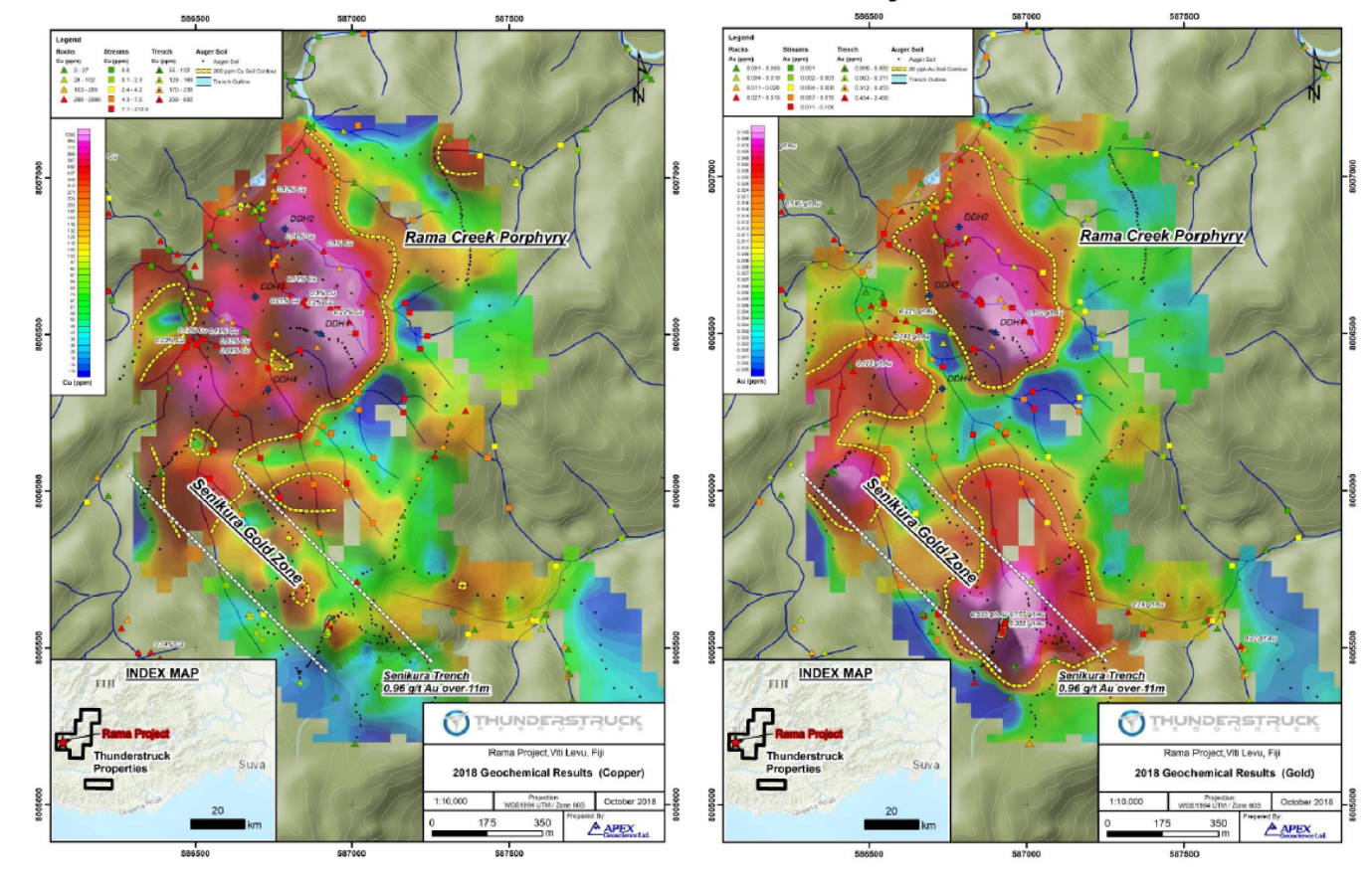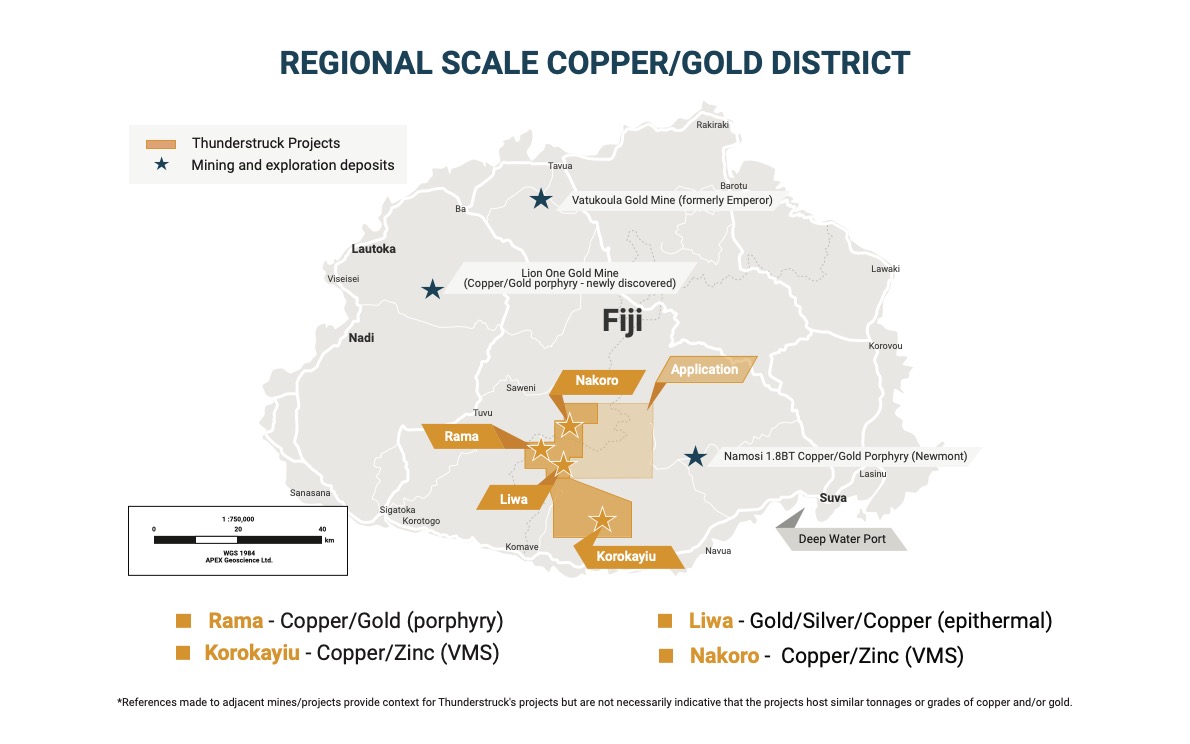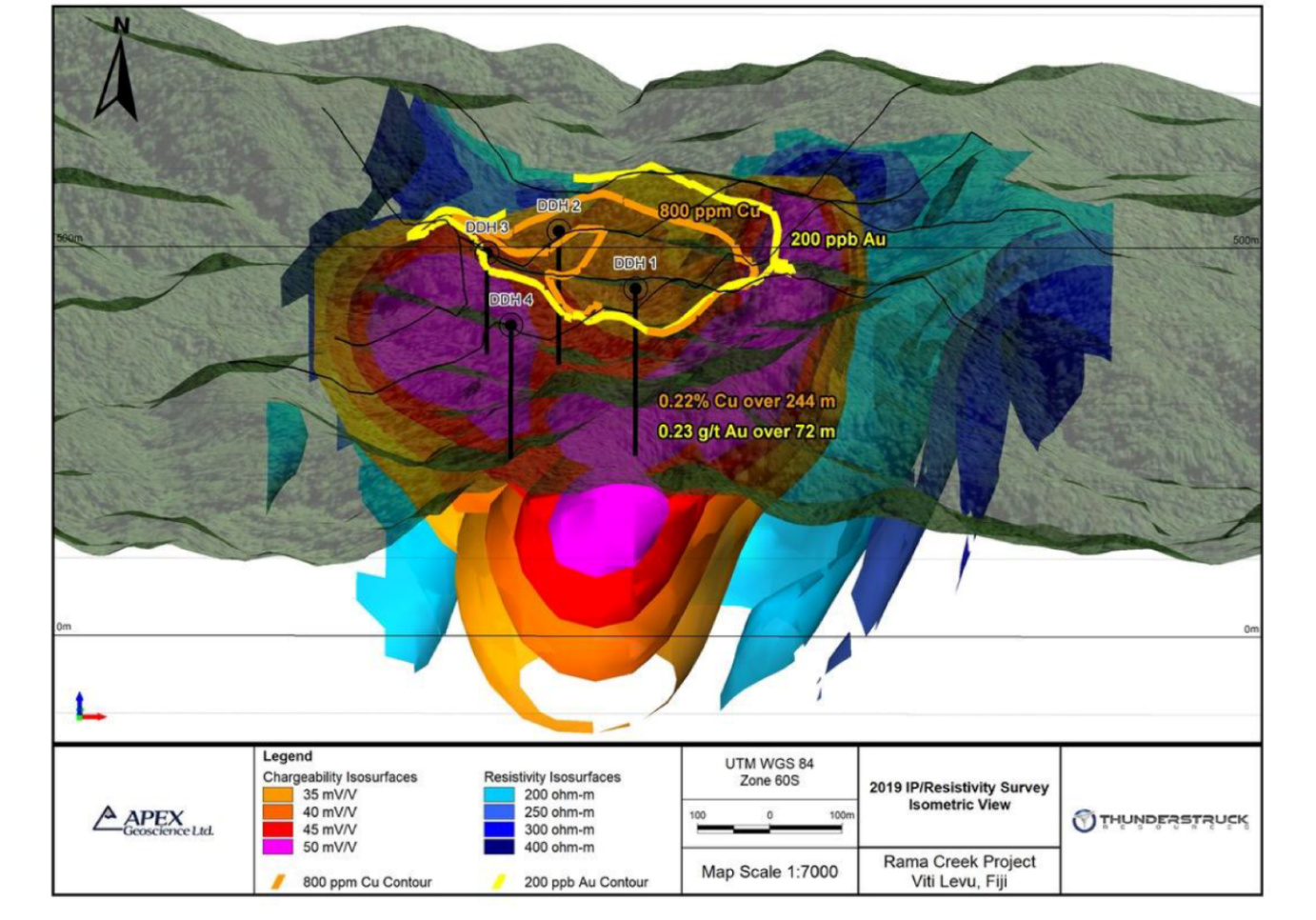Overview
Thunderstruck’s 100% owned Rama prospect is a large 2.5km by 2.5km classic copper/gold porphyry system in southern Fiji.
The Senikura Gold Zone to the south of Rama is a newly discovered high priority porphyry target over a 300m X 200m establishing a clear link between higher-level, gold-rich disseminated mineralization located at high-elevations on the Senikura ridge with the historic copper/gold mineralization identified by Anglo at Rama in the 1970s. The Company interprets these zones to be part of the same large porphyry system.
Thunderstruck has undertaken surface geochemical and geophysical exploration campaigns, resulting in numerous anomalous geophysical, rock, trench, and soil samples confirming and extending zones of known gold and copper mineralization.
Rama appears to be an analog and adjacent to Newmont’s 1.8B tonne Namosi copper/gold porphyry.
Since acquiring Rama, multiple access roads have been built allowing for the discovery of other highly prospective copper and gold bearing targets throughout the district.
Location
Rama is located within a large regional copper/gold district on Fiji’s main island of Viti Levu and is one of several porphyry clusters within Thunderstruck’s ~320 km2 land package. Rama lies approximately 30 km west of the Namosi copper/gold porphyry, a Newmont/Mitsubishi Joint Venture which hosts 6.3M Tonnes Copper and 6.93M Oz. Gold (1.8 Billion Tonnes @ 0.35% Cu + 0.11 g/t Au Measured & Indicated; Newcrest Mineral Resource Update, June 2023).
History
The Rama porphyry prospect was discovered in 1971 following reconnaissance stream sediment sampling, geologic mapping and geophysical surveys carried out by Barringer Fiji Ltd. Following discovery, Barringer entered a joint venture with Australian Anglo American Ltd (Anglo).
In 1975 Anglo defined the central Rama porphyry Cu-Au target through a combination of soil / rock chip sampling and drilled four short vertical diamond drill holes for a total of 802 m (figure 2). Hole DDH-1 returned 72m @ 0.32% Cu + 0.25 g/t Au (6-78m) within a broader interval of 244m @ 0.22% Cu + 0.16 g/t Au (6-250m; this hole ended in mineralization). Anglo only tested for copper, lead and zinc, with a limited number of samples tested for gold.
Anglo abandoned its exploration of Rama since it was only accessible by helicopter at that time, and focused on Namosi 30km SE with its more cost-efficient road access. Rama laid fallow for ~45 years until re-discovered by Thunderstruck in 2018, made possible by a newly built, comprehensive system of logging roads. It is now a drive-up prospect with multiple emerging porphyry clusters.
Geology and Mineralization
Geologically, Viti Levu has been exposed to a complexity of crustal plate rotations and has been dominated by island arc development followed by rifting, like that of neighbouring Pacific Rim countries. Magmatism, precious, and base metal emplacement occurred episodically throughout the evolution of the Fijian platform. The oldest known mineral occurrences were emplaced within low-k tholeiitic volcanics of the Wainimala Group, host to the Rama Porphyry prospect.
The prospect occurs in an area where basic and andesitic rocks of the Wainimala Group are intruded by Colo porphyritic intrusions. These intrusions consist of at least two phases. The earlier phase is an ellipsoidal tonalite – quartz diorite intrusion and the later phase is a quartz monzonite which occurs as dykes and small irregular bodies. Stockwork quartz veining occurs mainly in the tonalite, containing the bulk of the copper mineralization.
A recent academic study at Rama confirms that mineralization and alteration styles observed represent a classic porphyry style copper/gold system. The alteration, the study suggests, is associated with the potassic zone of a porphyry system and has been emplaced through structural controls. The porphyry system is thought to be exposed at moderate depth thus exposing convalesced argillic, phyllic and potassic alteration styles.
Thunderstruck Exploration
Thunderstruck has completed soil, rock, BLEG, trench and geophysical campaigns to better define the porphyry target. Based on the results of geological mapping completed by Thunderstruck, the Rama porphyry target exhibits strong a northwest-southeast structural control. The Rama stockwork veined porphyry zone is separated from the Senikura Gold Zone to the south by a wide northwest trending zone of hydrothermal brecciation.
Senikura Gold Discovery
Thunderstruck’s surface sampling, geophysical and trenching programs have highlighted zones with anomalous gold values and subsequently led to the discovery of the Senikura Gold Zone. The gold zone is an extensive zone of anomalous gold values over a potential 1.5 km strike, offset 1 km to the south of the interpreted centre of the Rama porphyry target. Extensive Ridge-and-spur auger soil geochemical sampling has both highlighted and extended the prospect. Furthermore the Senikura Gold Zone target returned trench results of 0.55 g/t gold over 37.6 m; including 0.96 g/t gold over 11 metres (see press release October 22, 2018).

IP/Resistivity Geophysical Surveys
At Rama a series of four survey lines, each 1.5 km in length, were targeted at what is interpreted to be the core of a copper-gold mineralized porphyry system. The results of the survey define an approximately 800 m diameter, bowl shaped, greater than 40 mV/V chargeability high and resistivity low anomaly within resistive, highly altered tonalite intrusive rocks outcropping at surface. The chargeability anomaly extends from surface to a vertical depth of approximately 500 m below surface, the limit of the geophysical inversion.
The chargeability and resistivity low anomalies are coincident at surface with semi-circular, greater than 800 ppm copper and greater-than-200 ppb gold ridge and spur soil geochemical anomalies. In addition, the historic diamond drill hole DDH1, with a 244 m interval averaging 0.22 % Cu and ending in mineralization (including a 72 m interval between 6 m and 78 m averaging 0.23 g/t gold), is coincident with IP chargeability anomalies1.
Significant Exploration Potential
The Rama porphyry prospect was underexplored by Anglo in the 70’s due to access issues, where sampling and a short hole drill program resulted in an 800m diameter copper porphyry discovery. Subsequent geophysics and geochemical programs by Thunderstruck has doubled the target size to 2.5km by 2.5km and it remains open in all directions. Further exploration is warranted which will include deep, angled drilling in conjunction with a large grid-based magnetic survey.
The Senikura Gold Zone to the south of Rama represents a predominance of primary mineralization and distal alteration assemblage and are interpreted to indicate a higher-level manifestation of the same magmatic hydrothermal system as Rama. Significant potential exists for the discovery of additional porphyry mineralization at depth beneath the gold zone.
1 Given the disseminated nature of porphyry copper-gold mineralization, the relationship between the drill intercepts and the true width of mineralization is not known.



